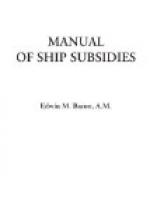“The system is calculated to secure regular and rapid postal communication with certain countries beyond seas, and at the same time to constitute an auxiliary fleet capable of being utilized by the navy in times of war. The existence of fixed lines with constant service is also a means of favoring the expansion of the national commerce. The State obtains, moreover, in exchange for the subsidy, direct advantages; the free carriage of the mails and the funds of the public treasury; transport of officials at a reduced price, and of arms and stores destined for the service of the State.”
Meeker:
“The greater part of the concealed subventions undoubtedly goes to the shipbuilders, for all mail contract steamers must be built in French yards and of French materials. These first costs are estimated to be from twenty-five to fifty per cent greater in France than in England."[CG]
There is no competition in the letting of the French mail contracts. They go to four steamship concerns. For many years more than one half of the total steam tonnage of France has been owned by these four subsidized lines: the Compagnie Generale Transatlantique, the Compagnie des Messageries Maritimes, the Chargeurs Reunis, and the Compagnie Fraissant.[CG]
The great ship-yards have developed a capacity for building steamships of the largest class. The tonnage since 1881, when it had fallen to 914,000 tons, had increased only to 1,052,193 tons in 1900. By 1910-11, it had reached 1,882,280 tons.[CH] The total mail subsidies average, in round numbers, five million dollars a year, while the construction and navigation bounties amount to three and a half million dollars additional.
Practically every French vessel floating the French flag and engaged in foreign trade either receives or has received subsidies, or bounties, from the Government.[CI]
FOOTNOTES:
[Footnote BD: Meeker.]
[Footnote BE: Lindsay, vol. III.]
[Footnote BF: Rear-Admiral Alfred T. Mahan, “The Influence of Sea Power upon History,” pp. 105-107.]
[Footnote BG: Mahan, p. 73.]
[Footnote BH: Lindsay, vol. III.]
[Footnote BI: Prof. Achille Viallates, “How France Protects Her Merchant Marine,” in North American Review, vol. 184, 1907.]
[Footnote BJ: Lindsay, vol. III.]
[Footnote BK: Lindsay, vol. III, also Viallates.]
[Footnote BL: Viallates.]
[Footnote BM: Lindsay, vol. III, pp. 457-458.]
[Footnote BN: Viallates.]
[Footnote BO: Meeker. Also Wells, pp. 163-164, note.]
[Footnote BP: Wells, pp. 163-164, note.]
[Footnote BQ: Meeker. Also Wells.]
[Footnote BR: Wells, p. 164.]
[Footnote BS: Meeker.]
[Footnote BT: Viallates.]




